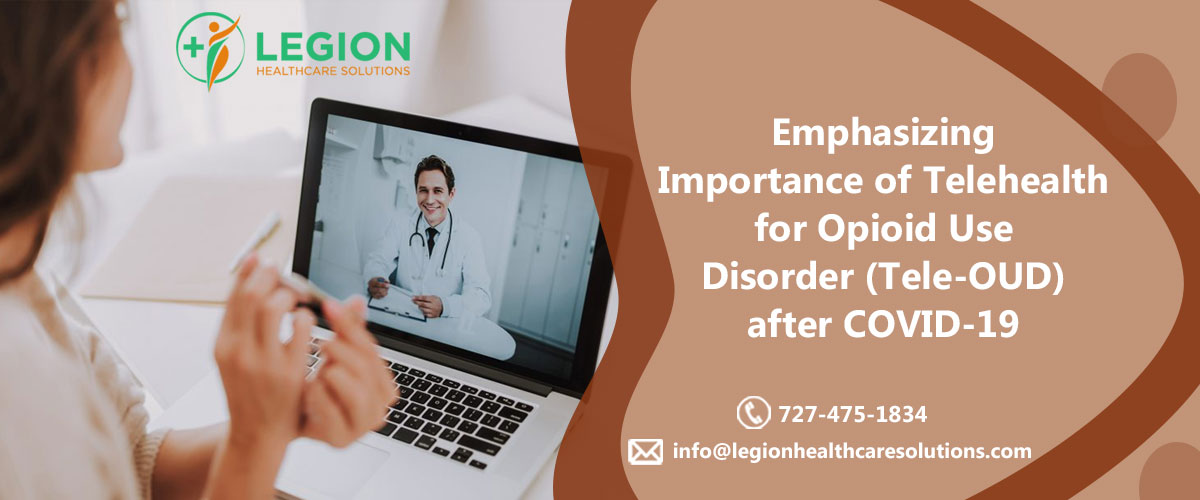
Emphasizing Importance of Telehealth for Opioid Use Disorder (Tele-OUD) after COVID-19
The U.S. continues to face an addiction epidemic with over 90,000 people dying of opioid and other overdoses before the COVID-19 pandemic began. Recent estimate show that only 20-40 percent of patients with an OUD receive these medication treatments, and rates are even lower in many communities. Although numerous factors contribute to low treatment rates, the limited accessibility of trained providers is widely recognized as a major contributor. Telehealth is a promising approach to increase availability and reach of treatment services, and use and interest has grown for telehealth-delivered treatment of OUD since the COVID-19 pandemic. Let’s have detailed discussion on emphasizing importance of telehealth for Opioid Use Disorder (Tele-OUD) after COVID-19.
One study examined OUD treatment in the initial months after the start of COVID-19 and found major increases in telehealth use. This report also highlighted major increases in both video and phone delivery of OUD and other substance-related treatment during the COVID-19 pandemic, with high interest in sustaining telehealth services post-COVID-19. Research on tele-OUD care is limited compared to other forms of telehealth-delivered care. However, studies that have examined real-world care delivered via telehealth and randomized trials for other conditions suggest that similar outcomes are possible to in-person treatment. What is unknown is the impact of other practice changes, including less frequent urine drug screens, and how those changes may impact outcomes including access to treatment and retention in OUD care.
Reimbursement
Medicare and Medicaid: The rules for Medicare reimbursement for outpatient telehealth changed prior to COVID-19 with the SUPPORT Act. The SUPPORT Act lifted the location restrictions so patients could access care from home. After the start of the COVID-19 pandemic, the requirement for video was dropped to allow telephone-only visits. Unlike for Medicare, federal Medicaid regulations do not limit how telehealth can be reimbursed by states. States have broad flexibility to deliver and pay for telehealth services. However, states vary widely in types of telehealth-delivered SUD services covered and many states are experimenting with a range of services, including assessment, medication management, and individual and group psychotherapy. Differences exist at all levels from where a service can be provided, to what technology can be used, to what location billing codes are applied, and can even depend on whether patients are covered by fee-for-service Medicaid or a Medicaid managed care plan.
Commercial Insurance: For commercial health insurance, before COVID-19, most states had requirements to cover telehealth if the equivalent in-person care is covered, although only 10 states required reimbursement to be at the same rate as in-person visits. About half of states required cost-sharing to be the same for in-person and telehealth visits. During the COVID-19 public health emergency, many of the largest commercial payers loosened their telehealth requirements. Rules around payment parity and telephone-only encounters are highly variable, and it is unclear what changes will stay in place. COVID-19 decreased federal and state regulatory barriers and increased reimbursement options for telehealth services. Some of these policy changes may continue after COVID-19 pandemic, but physicians will need to continue to adjust to the changing regulations and reimbursement policies relevant to OUD treatment.
Opioid Use Disorder (Tele-OUD) after COVID-19
Tele-OUD care will continue to evolve as policies change in the post-COVID-19 era and additional research examines the impact of telehealth on access to care and patient outcomes. However, if changes in treatment modality are needed, clinicians should consider the following to help patients manage the challenges of a transition:
- Initiate treatment planning and discussions with patients about planning for changes in care delivery well ahead of time. For example, some patients who are now accustomed to phone visits or who have transportation barriers or other family responsibilities may need to adjust to traveling for some in-person treatment visits. Rather than changing abruptly or completely to in-person care, many patients may need the flexibility of a hybrid model with telehealth visits at times, especially during the transition. It is critical to minimize even brief disruptions in care, particularly for the treatment of OUD.
- Monitor changes in policies and guidelines at the state and federal level. We encourage policymakers to create and maintain a transparent central repository of policies. Clinicians can also work with their own healthcare system to ensure they are adhering to policies and advocate for changes as needed. Any policy changes may have substantial impacts for many of our patients, some of whom have only known buprenorphine treatment via telehealth. Some disadvantaged groups of patients may have only accessed care via telephone and could be at serious risk of treatment disruption, depending on how regulations and reimbursement change.
COVID-19 has changed how SUD care is delivered in the United States. Prior to COVID-19, telehealth for SUD was rarely used; during the pandemic, care in much of the U.S. transitioned to telehealth as the primary modality. For many patients, the ideal model may be a hybrid of in-person and virtual care that is individualized based on patient needs and preferences. For example, a patient who does not have reliable access to transportation may do best starting buprenorphine treatment virtually, have frequent video and phone visits with the prescribing clinician and other staff, but have intermittent in-person visits as needed when it is feasible for them to travel to the clinic. The optimal balance will need to be informed by future research to determine which patients benefit from varying mixtures of in-person and virtual care.
High quality care is the goal of OUD treatment regardless of where or how that treatment is delivered. The current challenge is to improve access and utilization of evidence-based treatments that are currently only used by a minority of patients. A related challenge is to improve the quality of care delivered to patients with OUD. The foundations of high-quality OUD care are the same regardless of how and where it is delivered. The goal of telehealth for OUD care is patient-centered and evidence-based treatment focused on understanding and addressing the needs of patients. The expansion of telehealth is an opportunity to reassess which aspects of our current practice improve patient outcomes and which create barriers that further stigmatize patients with OUD and limit access to effective treatment.
Legion Health Care Solutions is a leading medical billing company providing complete billing and coding services. We referred expert report from ‘Providers Clinical Support System’ as a reference, you can refer the link for detailed understanding. In case any assistance needed for telehealth services, contact us at 727-475-1834 or email us at info@legionhealthcaresolutions.com
Get A Quote
[forminator_form id=”4528″]
